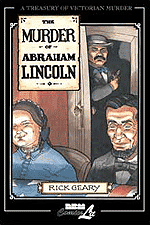
|
In a series of short true-crime books that involve high collars and hatchets rather than tracksuits and handguns, Geary tells his stories in the manner of a neutral but determined investigator sorting through the facts. Past books have covered such well-known cases as the Lizzie Borden murders, and lesser-known stories such as The Mystery of Mary Rogers. But no previous volume involves a story of nearly the historical magnitude of The Murder of Abraham Lincoln (80 pages; $16), perhaps the single most famous killing of its century. Combining his expert skills as a longtime cartoonist with a polished narrative drive and a sharp eye for bringing out surprising details, Geary's book reinvigorates this well-worn story with the excitement of a CSI episode and the historicity of a Ken Burns special.
Subtitled "A chronicle of 62 days in the life of the American Republic — March 4 - May 4, 1865," the book is a tick-tock of the events from the day of Lincoln's second inauguration to his burial. Using an authoritative voice-over narrative style, Geary carefully plots out the chronology of Lincoln's final days. In a typically compact opening sequence, excerpts from Lincoln's famous, conciliatory address, "With malice toward none; with charity for all..." get intercut with scenes that establish its historical context and Lincoln's fatalistic attitude about his own safety. The book then shifts to its primary character, John Wilkes Booth. Reduced to a rather flat villain in the collective historical memory, here Booth comes alive as a handsome actor and ladies man whose insatiable ego, as much as a muddled sense of Southern rebellion, drives him to seek the historical stage.
As the book moves closer and closer to the fateful moment it becomes more and more tightly wound, zeroing in on an hour-by-hour examination of the actions of the various parties. But The Murder never reads like an illustrated police report thanks to Geary's incredible efficiency at inserting details to bring out the personalities of the players. One episode shows Mary, the President's wife, in a foul mood during a military review. On the reviewing stand she denounces a general's wife as a whore. This appalling outburst would seem to have repercussions later when 15 couples, including The Ulysses S. Grants, would decline an invitation to accompany the Lincolns to the theater on April 14, 1865.
 Lincoln dreams of his own death in Rick Geary's "The Murder of Abraham Lincoln"
Lincoln dreams of his own death in Rick Geary's "The Murder of Abraham Lincoln" |
Those unfamiliar with the events surrounding the assassination will find many such details in this book that will surprise them. Originally, for example, Booth plotted to kidnap the President by abducting him from a theater box during a command performance. Also, Lincoln's assassination was part of a larger plot to simultaneously murder the Vice-President and Secretary of State, neither of which was successful. Sometimes Geary throws in a weird fact just for its color, such as Lincoln's spooky dream about his own assassination.
Using his wealth of experience cartooning for magazines and comix, Geary's engraving-style black and white drawings seem particularly suited to stories that date from over 100 years ago. Each panel has a masterful sense of mise en scene, like the staged photos of the time, giving them a powerfully dramatic look. Straddling the border between realism and simplified cartoon, Geary's caricatures also have a subtle whimsy about them that adds to the macabre sense of humor running through all the books of the series, including this one. One panel provides a bizarre close-up of Lincoln's brain as it is removed during his autopsy, like a scene from a horror movie.
The final quarter of the book tracks Booth's escape to Virginia, using false names and hobbled by a broken leg, where federal troops eventually catch up to him. He dies while resisting arrest with the final words, "Uselessuseless." Geary then wraps up his brief history with a survey of the remaining questions that still surround the events. For example, why did the government remove 18 pages from Booth's journal, and what became of them? Even such open-and-shut cases as Lincoln's murder seem to always have a bit of mystery about them.
Filled with rich detail and told with the tightness of a thriller, Rick Geary's The Murder of Abraham Lincoln makes for a remarkably entertaining and compact work of historical comix. Smart and moving, such well-done books have more to offer than merely being an easy way to learn about the past.
